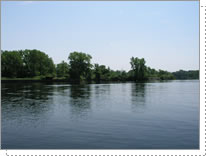Community Advisory Group (CAG)
Hudson River PCBs Superfund Site
Home
What's New
Next CAG meeting:Wednesday,January 14, 2026
1:00-4:00 PM
Virtual Meeting, Registration Required
Click here to Register for the Virtual Meeting
Overview
The CAG for the Hudson River PCBs Superfund Site is designed to:
- Promote broad, balanced representation of communities and stakeholders along the entire site, in this case the Hudson River;
- Encourage more routine and consistent communications and coordination between EPA and the community;
- Solicit ongoing recommendations about ways to enhance community involvement;
- Provide an avenue for the community to voice its needs and concerns;
- Provide for a consistent source of dialogue for EPA to gauge interests and needs.
 The
Hudson River CAG represents interests that were identified in EPA’s April 2003 Draft Community Involvement Plan for
the site. CAG members were selected by nominating organizations independently of EPA. The Hudson River PCBs Site CAG held
its first official meeting in January 2004. Since then, membership has evolved to reflect current project parameters.
The
Hudson River CAG represents interests that were identified in EPA’s April 2003 Draft Community Involvement Plan for
the site. CAG members were selected by nominating organizations independently of EPA. The Hudson River PCBs Site CAG held
its first official meeting in January 2004. Since then, membership has evolved to reflect current project parameters.
EPA provides organizational and informational support to the CAG, and provides financial support through the hiring of an independent, neutral facilitator. All general meetings of the CAG are open to the public and CAG meeting notices are publicized in advance. Every member of the community has the opportunity to become involved and express an opinion about the project and its elements at any time and does not have to rely on the CAG to convey that message. CAG meetings are held as needed, determined by the CAG Administrative Committee. Meetings are typically focused on current project activities.
Site Background
For 30 years ending in the late 1970s, the General Electric Company (GE) discharged polychlorinated biphenyls (PCBs) into the Hudson River from its capacitor manufacturing plants in Hudson Falls and Fort Edward, New York.
The Hudson River PCBs Superfund Site encompasses a nearly 200-mile stretch of the Hudson River in eastern New York State from Hudson Falls, New York to the Battery in New York City and includes communities in fourteen New York counties and two counties in New Jersey. The site is divided into 120-miles of the Upper Hudson River, which runs from Hudson Falls to the Federal Dam at Troy, a distance of approximately 40 miles, and the Lower Hudson River, which runs from the Federal Dam at Troy to the southern tip of Manhattan at the Battery in New York City.
EPA selected a cleanup plan in 2002 which called for dredging in the Upper Hudson River followed by an extended period of natural recovery. The dredging began in 2009 and finished in 2015. With dredging completed, the project is now in a long-term monitoring phase to track the river’s recovery over time. Other EPA work in the Upper Hudson continues, including a comprehensive study of PCB contamination in soil and sediment in a 43-mile stretch of the river’s floodplain, between Hudson Falls and Troy, NY. Most recently, EPA began an investigation focused on the Lower Hudson River which includes extensive water, fish and sediment sampling between Troy and the Battery in New York City. Additional information about EPA’s previous Hudson River work and the status of the Superfund cleanup is available on EPA’s site webpage: www.epa.gov/hudsonriverpcbs.
What is a CAG?
Community Advisory Groups (CAGs) are a community initiative and responsibility. CAGs are intended to provide a forum through which a broad and diverse sample of community needs and interests are represented.
The purpose of the CAG is to provide a way for members of communities and stakeholders to present and discuss their needs and concerns related to the site design and cleanup decision-making process. It offers EPA an opportunity to hear and consider community input on the design and impacts of the selected remedy.
While not a required community involvement activity, the presence of a CAG at a Superfund site can greatly enhance the community involvement process. Not only does it serve as a forum for the regular exchange of information between members of the community and EPA, an active CAG can help improve communication between community members.
CAG Resources
EPA's Hudson River Website
https://www.epa.gov/hudsonriverpcbs
EPA's Community Involvement Plan
https://www.epa.gov/hudsonriverpcbs/cleanup-plans-and-documents#cip
General CAG Information
https://www.epa.gov/superfund/superfund-community-advisory-groups
GE's Hudson River Website
http://www.hudsondredging.com